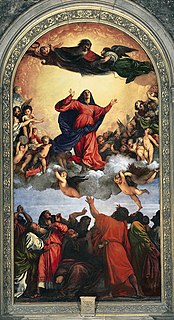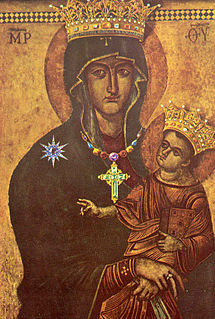Related Research Articles

Pope Pius XII, born Eugenio Maria Giuseppe Giovanni Pacelli, was head of the Catholic Church and sovereign of the Vatican City State from 2 March 1939 to 1958 when he died. Before his election to the papacy, he served as secretary of the Department of Extraordinary Ecclesiastical Affairs, papal nuncio to Germany, and Cardinal Secretary of State, in which capacity he worked to conclude treaties with European and Latin American nations, such as the Reichskonkordat with Nazi Germany.

Pope Pius X was head of the Catholic Church from August 1903 to his death in 1914. Pius X is known for vigorously opposing modernist interpretations of Catholic doctrine, promoting liturgical reforms and orthodox theology. He directed the production of the 1917 Code of Canon Law, the first comprehensive and systemic work of its kind.
The Good Friday prayer for the Jews is an annual prayer in the Christian, particularly Roman Catholic, liturgy. It is one of several petitions, known in the Catholic Church as the Solemn Intercessions and in the Episcopal Church as the Solemn Collects, that are made in the Good Friday service for various classes and stations of peoples: for the Church; for the pope; for bishops, priests and deacons; for the faithful; for catechumens; for other Christians; for the Jews; for others who do not believe in Christ; for those who do not believe in God; for those in public office; and for those in special need. These prayers are very ancient, predating the eighth century at least and may be from as early as the second century.
In the Catholic Church, a jubilee is a special year of remission of sins and universal pardon. In Leviticus, a jubilee year is mentioned to occur every 50th year, during which slaves and prisoners would be freed, debts would be forgiven and the mercies of God would be particularly manifest.

Mystici corporis Christi is a papal encyclical issued by Pope Pius XII on 29 June 1943 during World War II. It is one of the more important encyclicals of Pius XII because of its topic, the Church, which was strongly debated and further developed in the Second Vatican Council document on the Church, Lumen gentium.

Munificentissimus Deus is the name of an apostolic constitution written by Pope Pius XII. It defines ex cathedra the dogma of the Assumption of the Blessed Virgin Mary. It was the first ex-cathedra infallible statement since the official ruling on papal infallibility was made at the First Vatican Council (1869–1870). In 1854 Pope Pius IX made an infallible statement with Ineffabilis Deus on the Immaculate Conception of the Virgin Mary, which was a basis for this dogma. The decree was promulgated on 1 November 1950.
In persona Christi is a Latin phrase meaning "in the person of Christ", an important concept in Roman Catholicism and, in varying degrees, to other Christian traditions. A priest is In persona Christi, because he acts as Christ and as God. An extended term, In persona Christi capitis, “in the person of Christ the head,” was introduced in by the bishops of the Vatican Council II in the Decree on the Ministry and Live of Priests, Presbyterorum Ordinis, December 7, 1965.
Mediator Dei, a papal encyclical, was issued by Pope Pius XII on 20 November 1947. It was the first encyclical devoted entirely to liturgy. The encyclical suggested new directions and active participation instead of a merely passive role for the faithful in the liturgy, in liturgical ceremonies and in the life of their parish. The encyclical also emphasized the importance of the Eucharist. Mediator Dei is one of the more important encyclicals of Pope Pius XII. The encyclical condemned certain excesses of liturgical reform and stressed the importance of the union of sacrifice and altar with communion, which greatly directed the reforms undertaken during and after Vatican II. It was written in part in response to the liturgical movement under way since early in the 20th century.
Anni sacri issued on the twelfth anniversary of his coronation, is an encyclical of Pope Pius XII on a program combating atheism.
The Church policies after World War II of Pope Pius XII focused on material aid to war-torn Europe, the internationalization of the Roman Catholic Church, its persecution in Eastern Europe, China and Vietnam, and relations with the United States and the emerging European Union.
Cupimus Imprimis is an apostolic letter of Pope Pius XII to all the faithful in China regarding their persecutions and the persecution of the Catholic Church.
Veritatem Facientes is an apostolic letter of Pope Pius XII to the Catholic faithful of Romania, protesting against their persecution and the virtual eradication of the Catholic Church in their country. The letter asks for courage and prayers.
Acerrimo moerore is a letter of Pope Pius XII to the Hungarian Episcopate after the jailing and torturing of Cardinal Joseph Mindszenty.

Fulgens corona is an encyclical by Pope Pius XII, given at St. Peter's, Rome, on 8 September 1953, on the Birthday of the Virgin Mary, the fifteenth year of his Pontificate. The encyclical proclaims a Marian year for 1954, to commemorate the centenary of the definition of the dogma of the Immaculate Conception of the Virgin Mary. Fulgens corona is significant as it contained the mariological methodology of Pope Pius XII and his views on limits and challenges of mariology.

The theology of Pope Pius XII is reflected in his forty-one encyclicals, as well as speeches and nearly 1000 messages, during his almost 20-year pontificate. The encyclicals Mystici corporis and Mediator Dei advanced the Catholic understanding of membership and participation in the Church. The encyclical Divino afflante Spiritu began opening the door to historical-critical biblical studies. But his magisterium was far larger and is difficult to summarize. In numerous speeches Catholic teaching is related to various aspects of life, education, medicine, politics, war and peace, the life of saints, Mary, the mother of God, things eternal and temporal.

The Mariology of the popes is the theological study of the influence that the popes have had on the development, formulation and transformation of the Roman Catholic Church’s doctrines and devotions relating to the Blessed Virgin Mary.
Mirabile illud is an encyclical of Pope Pius XII on the crusade of prayer for peace, given at Rome from St. Peter's on the sixth day of December, the year 1950, the twelfth of his Pontificate.

Le pèlerinage de Lourdes is the only encyclical of Pope Pius XII issued in French. It includes warnings against materialism on the centenary of the apparitions at Lourdes. It was given at Rome, from St. Peter's Basilica, on the feast of the Visitation of the Most Holy Virgin, July 2, 1957, the nineteenth year of his pontificate.
Eastern Catholic victims of Soviet persecutions include bishops and others among the tens of thousands of victims of Soviet persecutions from 1918 to approximately 1980, under the state ideology of Marxist–Leninist atheism.
The relations between Pope Pius XII and Judaism have long been controversial, especially those questions that surround Pope Pius XII and the Holocaust. Other issues involve Pius's Jewish friendships and his attitude towards the new state of Israel.
References
- ↑ Source: Jubilaeum Maximum, 1950, Libreria Editrice Vaticana, 1949
| This Catholic canon law–related article is a stub. You can help Wikipedia by expanding it. |
